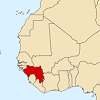Frank Bessem's Musiques d'Afrique
Back to Musiques d'AfriqueRetour aux Musiques d'Afrique
:: Cette page en français ::
Guinea
Country Overview
The popular music of Guinée, based on rich traditions,
was strongly promoted by the first President and dictator Sékou Touré, who ruled Guinea
from 1958 until his death in 1984. The newly independent state needed an orchestra to foster the development
of it musical heritage, and the Syli Orchestre National was created. Very soon, too many
talents came together in this one orchestra, and it was split in two ensembles, the Orchestre
de la Paillote, which was later renamed into Kélétigui et ses Tambourinis, and
the Orchestre du Jardin de Guinée, later Balla et ses Balladins.
Though already before independence, Facelli Kanté (1922-1961) was inspired by Fodeba Keita's guitar playing during theatre plays, and together they were to form the nucleus of the Les Ballets Africaines (cf. Charry : Mande music, p. 246). During the 1950s, Facelli Kanté made some recording with his African Ensemble as well as with the Ballet.
• State Support during the Sekou Touré era
Extensive state support throughout the 1960s and 1970s led to the formation of a variety of local, regional and national orchestras. The best ones were given the opportunity to record for the state record label Syliphone, and some even to travel, study and perform in Cuba. This all resulted in numerous LPs and singles on the Syliphone label, all with very fine music.
• First international successes
Of all bands, it was Bembeya Jazz National who succeeded to yield some international success, mainly after visits to Europe in 1985. But the era of the big orchestras came to an end as after Sekou Touré's death there was no State support anymore. Syliphone closed and most orchestras stopped performing on a regular basis, losing their most prominent members who started seeking exile in Europe or a solo career. The most successful artist from Guinée, Mory Kanté, had worked in Mali, Côte d'Ivoire and France, started a solo career around the same time, and had a number one hit in various Western countries with his 1987 version of « Yeke Yeke ».
• The younger generations
In Conakry, there is a younger generation of musicians waiting to break through. Apart from the mandingo style, there is reggae, rap, afro-zouk, fula music and semi-traditional ensembles from the coastal area in and around Conakry. Unfortunately, access to international studios, contracts and audiences remains difficult.
Though already before independence, Facelli Kanté (1922-1961) was inspired by Fodeba Keita's guitar playing during theatre plays, and together they were to form the nucleus of the Les Ballets Africaines (cf. Charry : Mande music, p. 246). During the 1950s, Facelli Kanté made some recording with his African Ensemble as well as with the Ballet.
• State Support during the Sekou Touré era
Extensive state support throughout the 1960s and 1970s led to the formation of a variety of local, regional and national orchestras. The best ones were given the opportunity to record for the state record label Syliphone, and some even to travel, study and perform in Cuba. This all resulted in numerous LPs and singles on the Syliphone label, all with very fine music.
• First international successes
Of all bands, it was Bembeya Jazz National who succeeded to yield some international success, mainly after visits to Europe in 1985. But the era of the big orchestras came to an end as after Sekou Touré's death there was no State support anymore. Syliphone closed and most orchestras stopped performing on a regular basis, losing their most prominent members who started seeking exile in Europe or a solo career. The most successful artist from Guinée, Mory Kanté, had worked in Mali, Côte d'Ivoire and France, started a solo career around the same time, and had a number one hit in various Western countries with his 1987 version of « Yeke Yeke ».
• The younger generations
In Conakry, there is a younger generation of musicians waiting to break through. Apart from the mandingo style, there is reggae, rap, afro-zouk, fula music and semi-traditional ensembles from the coastal area in and around Conakry. Unfortunately, access to international studios, contracts and audiences remains difficult.
République de Guinée

Region:
West Africa
Capital: Conakry
Official language: French
Main ethnic groups:
Around 24, main groups are Fula (Peul), Mandinka (Malinké), Susu (Soussou), smaller groups are Baga, Kpelle, Kissi, Zialo, Toma, Guerzé
Flags courtesy of ITA's Flags of All Countries used with permission.
Guinean Artist Pages
- Les Amazones de Guinée
- Saifond Balde - New !
- Soul Bang's - New !
- Banlieuz'art - New !
- Fodé Baro
- Doura Barry
- Fatou Linsan Barry
- Bembeya Jazz
- Etoiles de Boulbinet
- Sayon Camara
- Sayon Bamba Camara
- Camayenne Sofa
- Ba Cissoko
- Espoirs de Coronthie
- Ibro Diabaté
- Prince Diabaté
- Sékou "Bembeya" Diabaté
- Sékouba Bambino Diabaté
- Alpha Yaya Diallo
- Djeli Moussa Diawara
- Joe Dioubaté
- Fac Alliance
- Fatala
- Horoya Band
- Instinct Killers - New !
- Kaloum Star
- Kamaldine
- Elie Kamano
- Kerfala Kanté
- Mory Kanté
- Mamady Keïta
- Kélétigui et ses Tambourinis
- Abdoulaye Kouyaté - New !
- Djeli Fodé Kouyaté
- Hadja Kouyaté
- Moh! Kouyaté - New !
- Mory Djely Deen Kouyaté - Nouveau !
- N'faly Kouyaté
- Sékou Kouyaté - New !
- Missia Saran
- Lama Sidibé
- Tiranké Sidimé
- Maciré Sylla
Useful links on Guinean Artists

